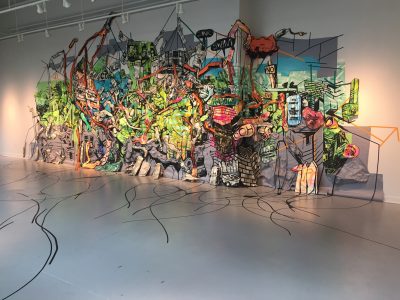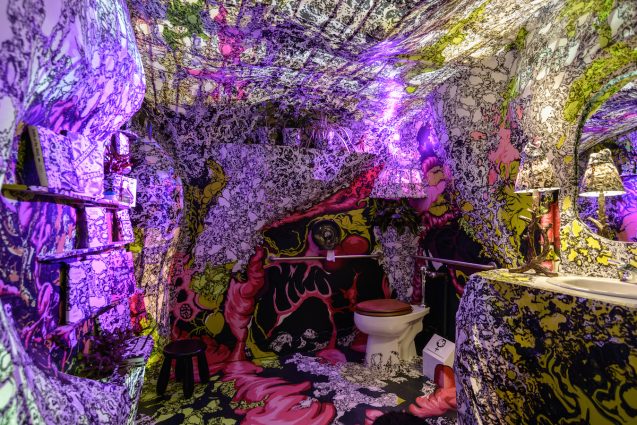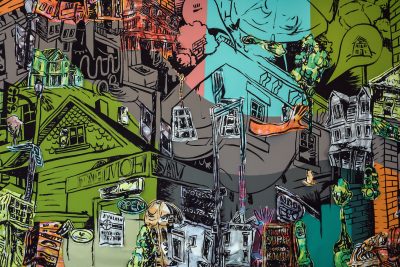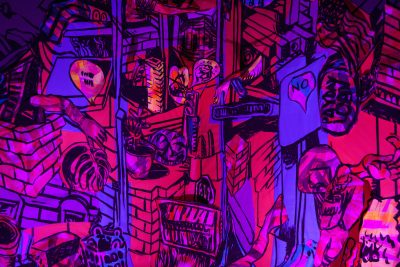An over-the-walls and onto-the-ceiling skyscraper city is plastering VisArts’ Gibbs Street Gallery in Rockville. It is not constructed of brick and mortar; nor is it nailed together with two-by-fours. Instead, Baltimore artist Amanda Burnham’s installation, “Civic Body,” is created from scraps of painted and penciled paper and plenty of adhesive tape.
Sure, some architects and planners dream of perfectly manicured avenues and properly proportioned buildings. Burnham is more interested in the raggedy edges and ill-fitting buildings that constitute most urban spaces. As for the hordes of people associated with said cities, Burnham sees the gallery’s visitors as an integral part of this ephemeral site from the moment they walk into the installation and move through it together in groups or alone.

Even pedestrians walking down Gibbs Street get involved. “The Gibbs Street Gallery isn’t hermetic; people can see into the gallery from the street,” Burnham said.
The gallery setting “allows me to build buildings that surround the viewer and are able to be taken in peripherally. By engulfing the viewer–building it out off the wall–sometimes from the ceiling … there is no single viewpoint.” In her experience, these large installations “mirror more faithfully than presenting single inherently hierarchical views in a more traditional format.”
With more than 175 submissions for the seven solo exhibitions planned for 2017 in the Gibbs Gallery, Burnham’s work easily rose to the top, said Susan Main, VisArts’ gallery director and curator.
Melissa Webb, the exhibition manager of Baltimore’s School 33 Art Center, is delighted with the semi-permanent installation, “Co-Lab(oration): The Way Out House,” that Burnham created in collaboration with artist Laure Drogoul. Funded by the Robert Rauschenberg Foundation, they were tasked to create an art installation in a public lavatory. The pair opted to decoupage and paint the room as a whimsical digestive system–complete with plants, purple grow lights and even bathroom reading material on the shelves. “Yesterday, a woman went into the restroom and screamed with joy” upon experiencing the space for the first time, Webb said.

In graduate school, Burnham tried to create a political voice in her artwork. Yet a professor’s critique changed her methodology. “My message wasn’t focused,” she recalls. “I was getting a reception that was different from what I intended. And because I intended a very particular sociopolitical message, I found it troubling to understand that some viewers took away from the work the opposite of what I meant.”
At that point, the artist began depicting the world without the “explicit intent to mold” what she saw to “advance a political agenda or idea.” In lieu of that, “the act of paying attention, as embodied through the act of drawing and recording, could itself be political.”
Burnham’s inspiration for creating these mega-installation drawings began about a decade ago, after she earned a master of fine arts degree at Yale University and moved to Baltimore to teach art at Towson University.
Uninterested in drawing in her home studio, Burnham wanted to experience this Mid-Atlantic town. Out and about, a variety of folks would see and comment on her sketches; these conversations gave her insight into Baltimore’s inner workings. As a result, she created “observational drawings” and her “focus got sharper.”
For Burnham, drawing en plein air on the streets of Baltimore wasn’t the least bit intimidating; she grew up carrying a spiral notebook and a bunch of pencils and pens, always observing and drawing the world around her. “Once my brother and I filled a notebook, my mom would give us a new one,” she explained.

Burnham was raised in Sylvania, Ohio, a suburb near Toledo. “I had romantic depictions of cities from popular media. I hadn’t been further than Pittsburgh before I went to Harvard,” where she earned a bachelor of arts degree in visual and environmental studies.
“The Boston area made a huge impression on me,” Burnham said. “It was much more complicated. There is a push-pull. From the beginning, I was taken away from living in a community with people who act like you. It wasn’t hard to see the structural inequalities.” Some neighborhoods were valued, while just a block away, everything was clearly the opposite.
Now Burnham spends most weekdays teaching art classes to freshmen and working with seniors as they create their portfolios. “I see them in the beginning and the end, not in the middle,” she said.
While appreciating how teaching has energized her own work, she also tries to help her students see how their art training will enhance whatever career path they eventually chose. After all, she ever considered art as a profession while growing up.
“I didn’t know any artists. I never thought conceptually that I could be an artist,” she explained. “I loved school, writing, reading. I was kind of a nerd. I didn’t want to go to art school. I wanted to learn other things.” When Harvard sent her an informational letter and brochure, she was surprised and flattered.
Her naivety served her well. When it came to the college interview, “I wasn’t polished; you can’t check the boxes and fake it,” she said.

Once in Boston, Burnham relished those four years of study and assumed she would pursue graphic design or museum work. She had an internship in graphic design, but it didn’t feel right. Upon graduating, she moved to New York City and drifted from working as an artist’s assistant to a paralegal to a job in the education department at the Museum of Modern Art (MOMA).
At MOMA, she worked with students from kindergarten through grade 12, often collaborating with their teachers, showing the youngsters artwork that correlated with what they were studying in school. “I wasn’t an extrovert and I was scared to be in front of the class, but I sucked it up and realized I liked teaching,” she said.

So many years after first seeing Boston, then living in New York City and now in Baltimore, Burnham said she is still learning about the energy and physicality of this planet’s unique urban spaces. Last summer, she was in Shanghai for an artist residency at the Swatch Art Peace Hotel. That city, she said, “lives up to its reputation with the huge volume of humanity.”
Now Burnham is considering how she can depict the throngs of people in her future work–whether that means replacing a painted I-beam with a leg or an arm or perhaps putting an ear in her architectural elements.
No matter what she decides, this exhibit is well worth the scotch tape.
“Civic Body,” Amanda Burnham’s installation, is on view through June 4 at VisArts, 155 Gibbs St., Rockville. Gallery hours are Wednesday and Thursday, noon to 4 p.m.; Friday, noon to 8 p.m., and Saturday and Sunday, noon to 4 p.m. Call 301-315-8200 or visit www.visartsatrockville.org. View this exhibit on CultureSpotMC here.